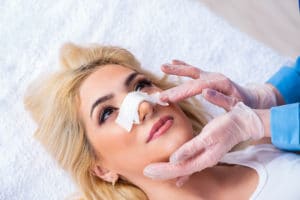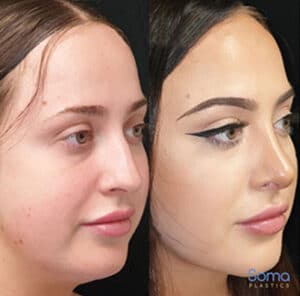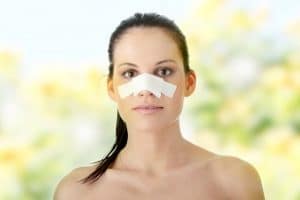What is this procedure?

“Rhinoplasty,” derived from the Greek words rhinos (“nose”) and plassein (“to shape”) is a surgery performed to achieve two results:
- To improve the breathing function of the nose and/or
- To improve the cosmetic look of the nose.
Rhinoplasty, sometimes referred to as a “nose job” or “nose reshaping”, enhances facial harmony and the proportions of your nose. It can also correct impaired breathing caused by structural defects in the nose. Rhinoplasty, or nose reshaping surgery, improves the shape, size, and symmetry of a person’s nose, bringing it into better proportion with the rest of the face. Revision rhinoplasties are essentially rhinoplasties, but more complex due to the complicated anatomy of the nose as a result of the initial surgery. A revision rhinoplasty is carried out because the initial rhinoplasty or primary rhinoplasty resulted in an unsatisfactory results, including but not limited to sinus problems, nasal collapse and/or deformity, deviated septum, crooked nose, dorsal hump on the nasal bridge, sleep apnea and/or snoring, and/or a drooping nasal tip.
When did they start this procedure?
Surgical rhinoplasty began in ancient Egypt and ancient India. In 800 BC, it was developed in India by the ayurvedic physician Sushruta. Revision rhinoplasties are still rhinoplasties, but they are more complicated. They have doubled in popularity since 2017, and that is due to a number of reasons, one of them being an increase in primary rhinoplasties, and in turn an increase in botched surgeries.
Who needs this procedure?
Men and women of all ages undergo rhinoplasties. Nose reshaping is one of the more popular cosmetic surgery procedures for teenage patients. Younger patients also need to demonstrate emotional maturity and understanding about the cosmetic surgery process. Rhinoplasty can change the size, shape or proportions of your nose. It may be done to repair deformities from an injury, correct a birth defect or improve some breathing difficulties. The purpose of a revision rhinoplasty is to surgically correct a failed primary rhinoplasty. The primary rhinoplasty may have failed for various reasons, but ultimately, a patient was left unhappy with their results, whether that be due to aesthetic reasons or functionality reasons. For patients of any age, it is important to have realistic expectations. Rhinoplasty can help you improve upon your existing nose, but it cannot deliver “perfection” nor can it give you the nose of someone else.
Are there non-surgical treatments?
No, the purpose of a revision rhinoplasty is to surgically correct a previous rhinoplasty that failed to deliver satisfactory results.
What is the surgical treatment like local or sedation?
Anesthesia Options for Rhinoplast
Rhinoplasty can be performed under various depths of anesthesia including intravenous sedation (also called twilight anesthesia, MAC anesthesia, or IV sedation) and general anesthesia. Each option has advantages and disadvantages, including variations in cost, awareness, safety, and side effects. Because rhinoplasty is considered to be an elective, preoperative testing is sometimes performed to determine anesthetic suitability. Regardless of the anesthetic option, all rhinoplasty anesthesia is performed in conjunction with local anesthesia (lidocaine mixed with epinephrine) to numb the nose and reduce bleeding.
IV Sedation
Although many surgeons prefer intravenous sedation for rhinoplasty, this is not the best anesthetic approach for optimal safety, effectiveness, and comfort. Twilight anesthesia relies upon the skillful dosing of powerful anesthetics through an intravenous catheter. IV sedation must render the patient unconscious and motionless without suppressing respiration (breathing). Although some experienced anesthesiologists are very skilled at achieving just the right dose of anesthetic, in many instances the patient is not rendered fully unconscious and sudden movements or even a disoriented and combative patient may disrupt the operation. Although less expensive than general anesthesia, the risks, discomfort, and effectiveness of IV sedation make it inferior to general anesthesia.
General Anesthesia
With General Anesthesia respiration is maintained by a ventilator, the depth of anesthesia can be adjusted to keep blood pressure low and thereby minimize bruising, swelling, and bleeding. A motionless and comfortable patient with minimal bleeding translates into far better operating conditions and more favorable surgical outcomes.
Perhaps the biggest reason against the use of general anesthesia is fear of postoperative nausea and vomiting. Postoperative vomiting is not only unpleasant, but vomiting may dramatically elevate blood pressure levels leading to much heavier facial bruising, swelling, and discomfort. By combining narcotic-free general anesthesia with other medications that suppress nausea, the incidence of clinically significant vomiting following a rhinoplasty is significantly decreased. Surprisingly, the absence of narcotics does not appear to compromise effective pain control as most patients are off pain relievers within 24 hours of surgery. In fact, with most cases, the reduction in post-operative pain is a result of optimal intra-operative anesthesia care resulting in less tissue trauma.
What is the recovery like?
Revision Rhinoplasty Recovery
 Because a revision rhinoplasty is more complex than a primary rhinoplasty, the recovery timeline is slightly altered and the overall healing process is lengthened. Scar tissue will need more time to fully heal and soft tissues may be agitated by additional surgery, resulting in additional inflammation. You can expect swelling and some bruising around the eyes after surgery that will begin to improve after the third day, however, it can last up to two weeks. Expect your nose to have a little swelling, which may go away over the period of six months. The final shape of your nose will be apparent after it has completely healed which will take a minimum of one year but as long as two years. Strenuous activity for three to six weeks after surgery should be avoided. You may return to your social activities as soon as within two to three weeks without any recognizable signs that you had a procedure done.
Because a revision rhinoplasty is more complex than a primary rhinoplasty, the recovery timeline is slightly altered and the overall healing process is lengthened. Scar tissue will need more time to fully heal and soft tissues may be agitated by additional surgery, resulting in additional inflammation. You can expect swelling and some bruising around the eyes after surgery that will begin to improve after the third day, however, it can last up to two weeks. Expect your nose to have a little swelling, which may go away over the period of six months. The final shape of your nose will be apparent after it has completely healed which will take a minimum of one year but as long as two years. Strenuous activity for three to six weeks after surgery should be avoided. You may return to your social activities as soon as within two to three weeks without any recognizable signs that you had a procedure done.
During your rhinoplasty recovery, a splint and bandages will be placed on the outside of our nose to support and protect the new structures during initial healing. Packing is not as common for revision rhinoplasties. You may have a “nasal drip pad” under your nostrils to collect any blood that may drip from your nose. The splint is removed in about a week and your nose may be stuffy and you may experience congestion for a short time. The skin on the tip of your nose may be numb. You may have some itching or shooting pain as the feeling returns, however it is important not to scratch as you can damage your nose. While initial swelling subsides within a few weeks, it may take up to two years for your new nasal contour to fully refine. During this time you may notice gradual changes in the appearance of your nose as it refines to a more permanent outcome. Swelling may come and go and worsen in the morning during the first year following your rhinoplasty surgery. Remember – This is a revision rhinoplasty, so your recovery will not be the same as your initial rhinoplasty.
Activity
- Resting as much as possible, getting enough sleep will help you recover.
- Keep your head raised for several days after surgery. Sleep with your head up by using 2 or 3 pillows.
- Try to walk each day and increase the amount you walk everyday.
- It depends on the type of work you do and how you feel, but you should take a minimum of a week off from work.
- Avoid strenuous activities, such as bicycle riding, jogging, weight lifting, or aerobic exercise, for 2 to 3 weeks or until your doctor says it is okay.
- Do not blow your nose for at least 1 week after surgery. Wipe your nose gently with a tissue. If you need to sneeze, sneeze with your mouth open.
- Avoid bending over until you are told it is okay to do so.
- Do not rub your nose for 8 weeks. Use sunblock on your nose and wear a hat with a brim to avoid getting sunburn. Put on sunblock or makeup gently.
- No swimming for 1 week.
 Diet
Diet
- It is common for your bowel movements not to be regular right after your surgery.
- Try to avoid constipation and straining with bowel movements. You may want to take a fiber supplement every day. If you have not had a bowel movement after a couple of days, ask your doctor about taking a mild laxative.
Medicines
- Your doctor will tell you if and when you can restart your medicines, along with new medications he will give you.
- If you take blood thinners, such as warfarin (Coumadin), clopidogrel (Plavix), or aspirin, He or she will tell you if and when to start taking those medicines again.
- Take pain medicines exactly as directed.
- If your doctor prescribed antibiotics, take them as directed. Do not stop taking them just because you feel better. You need to take the full course of antibiotics.
Incision care
- After the stitches or staples are out, you may wash the incision with soap and water and gently dry the area.
- If you have strips of tape on the incisions, leave the tape on for a week or until it falls off. Or follow your doctor’s instructions for removing the tape.
Other instructions
- Put ice or a cold pack on your nose for 10 to 20 minutes at a time, every 1 to 2 hours for 3 days (when awake) or until the swelling goes down.
- Do not set glasses on your nose for 4 weeks.
- For 1 week, avoid wearing clothes that you pull over your head.
How long does it take?
A rhinoplasty generally takes 1.5 to 4 hours and is an outpatient procedure. As with any surgery, the time for revision rhinoplasty surgery varies from person to person and there is even more variation with this surgery due to a patient’s anatomy, prior rhinoplasties, possible damage from previous surgeries, goals of surgery, scar tissue, and cartilage needed.
REASONS THAT AFFECT SURGERY TIME
- Minimal changes will generally take about 1.5 hours. If there are more extensive changes taking place, then the surgery could last up to 3 to 4 hours.
- Method of rhinoplasty being performed. There are 2 types of procedures when it comes to rhinoplasty. One is open and the other is closed. While both require cutting inside the nose, open surgery requires an extra cut on the outside where the nostrils join together.
- The amount of grafting that needs to be done. If you are lengthening your nose or making it wider, you will probably need to have cartilage grafted in. The cartilage is taken from the nose, ears, or in some cases, a rib. This will add to the amount of time that the surgery will take.
- If you have breathing issues that need to be addressed, the surgery can take longer. There are 4 types of rhinoplasty that can help correct breathing difficulties: nasal septoplasty straightens a deviated septum; turbinate reduction reduces the mucous membrane-covered “shelves” of bone that are usually a source of allergy irritation; polyp removal; and nasal valve collapse.
- If dorsal or tip projection needs to be achieved via augmentation, it could lengthen the procedure time
How long has it been around?
 Rhinoplasties have been around for a long time. Before Jacques Joseph of Berlin became the father of modern cosmetic rhinoplasty, followers of Sushruta were refining the noses of 6th-century inhabitants of Northern India. His method involved removing flaps of skin from the forehead or cheek of the patient and using it to reconstruct a new nose. The Roman medic Celsus seems familiar with his techniques when he describes the reconstruction of lips, ears, and nose. Reconstructed noses of one kind or another were popular precisely because the removal of noses (and ears) was a common punishment in wartime or for those who committed adultery or treason. Sushruta and his followers developed their practice to replace those noses, genitalia, and ears that had been amputated for religious, military, or criminal punishment. But the reconstruction of the nose was not solely about treating the victims of harsh criminal systems; it was about beauty and even character. Changing the shape of one’s nose, therefore, was not just about repair or beautification; it was about improving social status. Nose jobs began to catch on in Europe in the late 16th century as a result of the syphilis epidemic. One of the lesser-known symptoms of syphilis is the manner in which it can destroy the soft tissue in the nose and lead to a gaping hole in the middle of the patient’s face. The result wasn’t just discomfort, it was also social stigmatization, so rhinoplasties were sought after to give people a part of their social identity back. Revision rhinoplasties have become more popular in the 21st century and have doubled since 2017. This may be due to an overall increase in rhinoplasties taking place and botched surgeries.
Rhinoplasties have been around for a long time. Before Jacques Joseph of Berlin became the father of modern cosmetic rhinoplasty, followers of Sushruta were refining the noses of 6th-century inhabitants of Northern India. His method involved removing flaps of skin from the forehead or cheek of the patient and using it to reconstruct a new nose. The Roman medic Celsus seems familiar with his techniques when he describes the reconstruction of lips, ears, and nose. Reconstructed noses of one kind or another were popular precisely because the removal of noses (and ears) was a common punishment in wartime or for those who committed adultery or treason. Sushruta and his followers developed their practice to replace those noses, genitalia, and ears that had been amputated for religious, military, or criminal punishment. But the reconstruction of the nose was not solely about treating the victims of harsh criminal systems; it was about beauty and even character. Changing the shape of one’s nose, therefore, was not just about repair or beautification; it was about improving social status. Nose jobs began to catch on in Europe in the late 16th century as a result of the syphilis epidemic. One of the lesser-known symptoms of syphilis is the manner in which it can destroy the soft tissue in the nose and lead to a gaping hole in the middle of the patient’s face. The result wasn’t just discomfort, it was also social stigmatization, so rhinoplasties were sought after to give people a part of their social identity back. Revision rhinoplasties have become more popular in the 21st century and have doubled since 2017. This may be due to an overall increase in rhinoplasties taking place and botched surgeries.
What are the complications?
What are the risks of a revision rhinoplasty?
With all procedures, there are benefits and risks- you will have to determine if the benefits align with your goals and if the risks and potential complications are worth it. From there it is up to you to decide if the benefits outweigh the risks, or vice versa. Your plastic surgeon and/or staff will explain in detail the risks associated with surgery. You will be asked to sign consent forms to ensure that you fully understand the procedure and any risks or potential complications. It is also important that patients go into the procedure with realistic expectations.
Revision rhinoplasty surgery risks include:
- Anesthesia risks
- Infection
- Poor wound healing
- Scarring and keloid formation
- Asymmetry
- Prolonged edema
- Change in skin sensation (numbness or pain)
- Nasal septal perforation (a hole in the nasal septum) is rare. Additional surgical treatment may be necessary to repair the septum but it may be impossible to correct this complication
- Difficulty breathing
- Unsatisfactory nasal appearance
- Skin discoloration and swelling
- Tip Necrosis
These risks and others will be fully discussed prior to your consent. It is important that you address all your questions directly with your plastic surgeon.
What can you do to speed up recovery?
You may be eager to see the results of your revision rhinoplasty, but the recovery process takes time. During this time, there are steps you can take to aid your body in it’s recovery and ensure that everything is healing properly.
Revision Rhinoplasty Recovery Timeline
The average revision rhinoplasty recovery timeline varies but may take as long as two years. That may sound like a long time, but it seems less drastic when it is broken down into a realistic and specific timeline. The following recovery milestones may vary from patient to patient:
24-48hrs: Rest! After 48 hours, you may continue light activities.
1 Week: Rest during the first week of recovery is of utmost importance. During this time the splint can be removed from your nose (after 7 to 10 days) and you can go out in public without showing significantly noticeable signs of surgery unless there is bruising around the eyes. This may take 2 weeks to resolve. It is safe to resume activities of daily living.
2 Weeks: The majority of the facial swelling has subsided and most of the bruising should have resolved. Patients should be able to breathe clearly out of their nose.
3-4 Weeks: You can safely return to cardiovascular activities such as jogging, swimming and cycling.
6 Weeks: The bones are stable; you can resume resistance workouts (weight lifting), wearing glasses and blowing your nose.
3-6 months: The numbness and abnormal sensations in your nose and nasal skin should be resolved.
1-2 Years: The healing process is complete or nearly complete – swelling should have subsided entirely and the nose’s new shape is fully refined. It will be important that you meet with your surgeon annually to review the progress and healing of your nose after your revision rhinoplasty.
Listen to Your Doctor
First and foremost, follow your doctor’s instructions. You will receive specific instructions on what medications to take, when to take them, how to care for the surgical site to prevent infection, and when you’ll need to come back in for a follow-up exam.
Listen to Your Body
Your plastic surgeon can see how your rhinoplasty recovery is going from the outside, but only you will know how you’re feeling on the inside! Listen to your body – if something doesn’t feel right after surgery, discuss it with your doctor right away.
Keep Your Head Elevated
You’ll need to keep your head elevated while you sleep for 6 weeks following your surgery. One of the easiest ways to do this is to prop your head up on two or three pillows or use a foam wedge. Sleeping in a recliner also works well. Sleeping on your side after rhinoplasty can prolong your recovery time by causing additional bruising and swelling, so it’s best to avoid it!
Use Cold Compresses
In the first 72 hours after surgery, using a cold compress can significantly help reduce swelling. Be careful not to apply the compress directly to your nose. Instead, apply it to your cheeks so that you don’t accidentally shift any bones or cartilage.
Get Plenty of Rest
The congestion you feel after surgery may make it more difficult to fall asleep, but rest is a vital part of the recovery process. Your body uses energy to heal itself, and getting a solid seven or eight hours of sleep each night gives your body time to restore that energy.
Maintain a Healthy Diet
Eating a balanced diet post-surgery can help to speed up your recovery by giving your body the nutrients it needs to heal itself. A diet consisting of nuts, meat, eggs, yogurt, fish, and other protein-rich foods will help your body rebuild the damaged tissue in and around your nose. You’ll also want to make sure you’re getting plenty of vitamins in your diet, namely Vitamin A and Vitamin C.
Stay Cool
Steamy showers, hot bowls of soup, and relaxing saunas are not beneficial to your swollen nose. Heat will cause the tissues in your nose to swell even more, which is why it’s best to stick to a diet of cool and room-temperature foods, take lukewarm showers, and stay out of the heat in the weeks after your procedure.
Don’t Blow Your Nose
After surgery, you’re going to experience some congestion for a few weeks, maybe even a few months. This feeling is caused by swollen nasal tissues. Resist the urge to blow your nose and talk with your doctor about using a saline nasal spray to gently moisturize your nasal passages until the swelling goes down. You can resume blowing your nose after 6 weeks from surgery.
Avoid Vigorous Exercise
In most patients, it takes roughly 6 weeks for the bones in your nose to heal following surgery, however this may change due to this being a revision surgery. During this time, you should avoid strenuous exercise. Even movements that seem harmless like stretching, lifting, or bending over can increase nasal swelling. Wait until your doctor gives you the green light to resume normal activity before you begin to ease back into your workout routine.
Don’t Wear Glasses
Sunglasses, reading glasses, prescription glasses – anything that puts pressure on your nose as it is healing can cause additional bruising, swelling, or even indentations that may require a revision rhinoplasty down the road. Your facial plastic surgeon will advise you on when it’s safe to start wearing glasses again. In the meantime, switch to contacts, if you can.
Stay Out of the Sun
It’s always a good idea to protect your skin from getting too much sun exposure, but this is especially important after a revision rhinoplasty. Not only is your nose more prone to getting sunburned in the weeks and months following the procedure, but too much sun can also lead to increased swelling while also causing darkening of your scars.
Avoid Aspirin
Don’t be tempted to use aspirin as a painkiller. It thins the blood, and this can make bleeding more likely and prevent the necessary blood clotting needed to speed up your revision rhinoplasty recovery. For this reason, aspirin should be avoided for two weeks before and after surgery. Vitamin E supplements, Ibuprofen, and Motrin should also be avoided for the same reason.
Do you need to rest up afterwards and for how many days?
Rest is an extremely important part of recovery – Below are guidelines and milestones to keep in mind as you are going through the post-operative healing process. It is important to remember, a revision rhinoplasty has a longer recovery time than a primary rhinoplasty, and that is dependent on the initial surgery, as well as scarring, healing, corrections made, and prior complications.
 1-5 days post-surgery
1-5 days post-surgery
Resting, icing, and hydrating your body will be essential in speeding up your revision rhinoplasty recovery.
Over these first few days, blowing your nose could open your incisions, so avoid doing so at all costs. You may also have a slight headache, but because aspirin and ibuprofen will increase your bleeding risk, it is important to avoid these medications and only take the medications prescribed by your surgeon. Just know that they might make you constipated, so be sure to increase your fiber intake and talk to your doctor about the use of laxatives. Your doctor will probably recommend using small, light ice packs on your eyes and cheeks for 15 minutes every hour, to reduce swelling. Just be sure not to put too much pressure on your nose.
Rest! Rest! rest!
1 week/7-10 days post-surgery
Between seven to ten days after surgery, your surgeon should remove your splint and cast, and you’ll get your first look at your revised nose. Keep in mind that the swelling is still going down, so your final result may look different from what you are currently seeing. Rest will still be highly beneficial during this time.
1-2 weeks post-surgery
Head back to work! But take it easy!
Once your splint is off and the worst of your swelling has gone down, you could head back to work, with makeup that has been lightly applied over your bruises. If you want to be really discreet, you may want to wait up to two weeks before returning to work so that the swelling has more time to go down.
2-3 weeks post-surgery
If you have glasses, you can wear them normally again.
Glasses can put pressure on the bridge or the sidewalls of your nose, which can complicate healing and feel really uncomfortable. After the few weeks, you may be able to start wearing glasses again for short periods, with frequent breaks.
3-6 weeks post-surgery
Start exercising again
In the first few weeks, exercise could increase your blood pressure to a point beyond what is healthy for your healing tissues.
You should follow your surgeon’s recommendations on physical activity and exercising. It is important to avoid any strenuous activity or exercise that increases blood pressure for the first three weeks post surgery.
For 3 months post-surgery
Keep your nose protected from trauma
It’s especially important to avoid any accidental bumps during these first three months of healing, when it’s more vulnerable.
Your surgeon will want to meet with you to check-in on the progress of your revision rhinoplasty.
6 months post-op
Expect a lot of swelling to have decreased, but don’t be surprised if there still is swelling present! Revision rhinoplasties take longer to heal than a primary rhinoplasty would.
At this point, your swelling should have dramatically subsided. Keep in mind that things are still healing and settling, so you still have about a ways to go before you see your final results.
1-3 years post-rhinoplasty
Evaluate your final results
Because this is a revision surgery, it may take a while before patients can review their final results. It ranges for each patient, but it could take as long as 2 years before a final evaluation may take place. It takes at least this long for your skin to shrink to the level of the revised underlying framework or bridge structure, and up to three years if you’ve had a lot of work on the tip. Since this is a revision surgery, the scar tissue will take longer to heal. Your surgeon will likely meet with you yearly to check the progress of your surgery.
Contact us today to learn more about this procedure.
